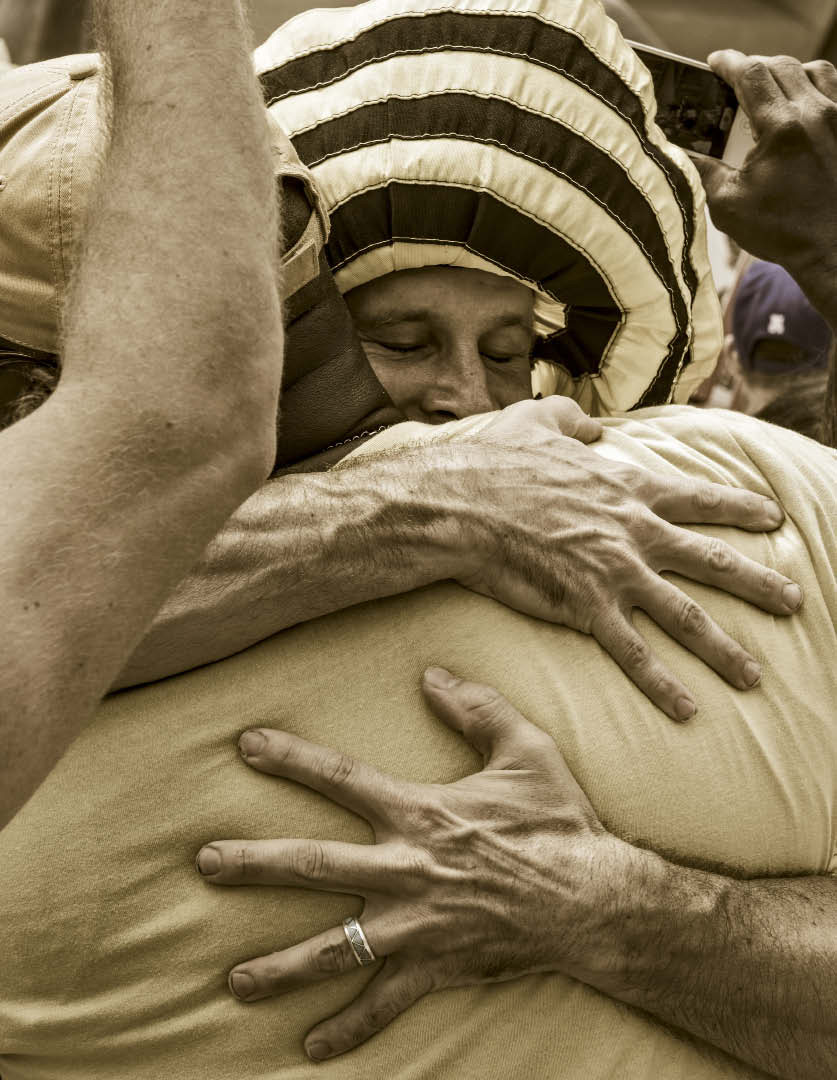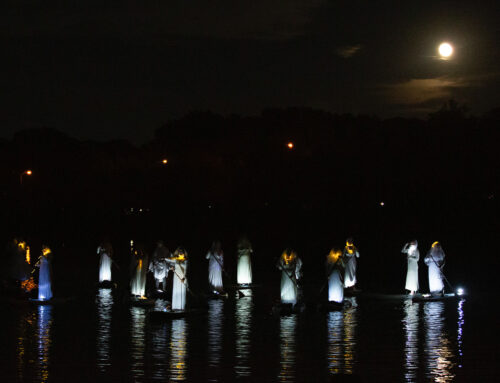Led by local apiculturists, Advocate photographer Danny Fulgencio looks at the lives of bees, their dwindling population and how it all impacts our lives.
Brandon and Susan Pollard of East Dallas herd honeybees. “Urban bee-wrangling,” they call it. Beyond being honey purveyors, the Pollards, via their Texas Honeybee Guild, save residential colonies from extermination, offer public education on the importance of bees and rally on their little charges’ behalf as environmental activists. As the Pollards often attest, bees are responsible for about 30 percent of our food. They pollinate more than 100 species of fruits and vegetables. Without them, we are in trouble. And that’s where we are headed, they say. In recent years, bee populations have been crushed by insecticides, disease, parasites and the enigmatic colony collapse disorder, a phenomenon that has caused the mysterious and widespread disappearance of worker bees. Last year proved especially brutal for the Pollards and their bees: The couple estimates they lost 60 percent of their hives, often after city-backed trucks and planes sprayed swaths of Dallas with neurotoxin to combat disease-carrying mosquitoes, which incidentally also threatens the humble bee. With mosquito season upon us, the Pollards attempt to rebuild their colonies while bracing for another possible round of chemical warfare.
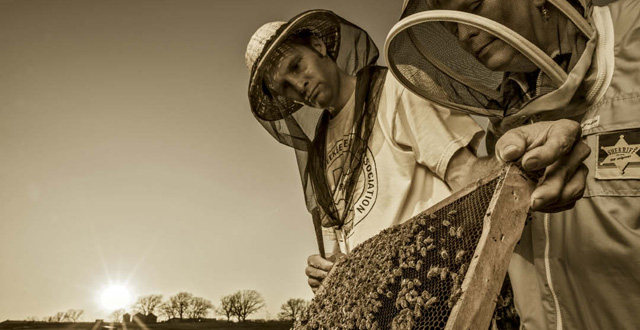
- HIVE CHECK The Pollards inspect a frame of bees at the John Bunker Sands Wetland Center just outside Dallas. The wetlands filter water from Dallas, which is then pumped back to the city. Honeybee colonies at the wetlands were not hit with neurotoxins during last year’s mosquito spraying, however, the apiculturists say, bees do drink water — and lots of it — and when the water is toxic, they die. Photo by Danny Fulgencio

BLOOD, SWEAT AND HONEY Weary beekeeper Susan Pollard wipes sweat off her brow as her partner and husband logs the condition of hives. As for wearing bee suits in thick Texas heat, Brandon Pollard says, “It’s all part of the bee-zness.” (Right) In their efforts to sustain and re-populate the species, the Pollards and their honeybee guild oversee several honey-producing hives in backyards and gardens around the city with a high concentration in the White Rock area. Zip Code Honey from those hives is sold in neighborhood eateries and stores, such as Natural Grocers. Photo by Danny Fulgencio
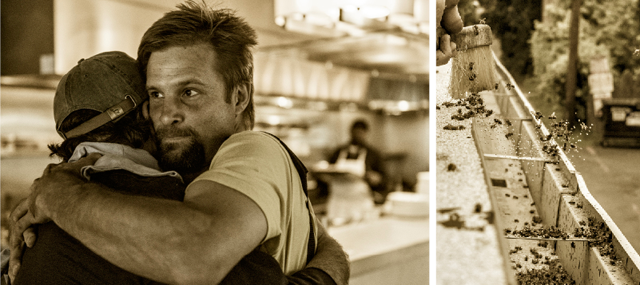
HUG THE CHEF (Above left) Brandon Pollard of the Texas Honeybee Guild embraces chef Graham Dodds at Central 214 on Mockingbird in East Dallas. Dodds, a fellow beekeeper and rescuer, has supported Brandon and Susan Pollard’s apicultural efforts by including Zip Code Honey in his craft. Through Zip Code Honey and organic-friendly chefs like Dodds, the Pollards hope to reconnect food consumers with their tiny pollinators.
A BEE’S DEATH (Above right) Brandon sweeps dead bees off a rooftop. The Pollards’ bee population is nearly impossible to measure. They’re wild animals, after all, whose numbers wax and wane seasonally. Quantifying their pollinators as hives is an arbitrary measure: A queen and a cup of bees is a colony; 60,000 bees in a box with a queen also is a colony. One thing’s for certain: The Pollards are challenged in maintaining the colonies that weren’t wiped out within the last year. Photo by Danny Fulgencio

SHOW AND TELL At an Earth Day celebration, Susan Pollard is reflected in a glass honeybee display case, one of the teaching tools she uses when advocating on behalf of the bees. Attendees seem struck with a mix of awe and nervous curiosity. Pollard educates them on the crucial importance of bees and how their benefits outweigh their danger. Some observers believe her and some don’t, it appears. Photo by Danny Fulgencio

RESTAURANT ROOFTOP HONEY (Above and Below Left) With the blessing of Corner Market owner Chuck Cole, the Pollards install a hive on the rooftop of the Greenville Avenue restaurant. Photo by Danny Fulgencio
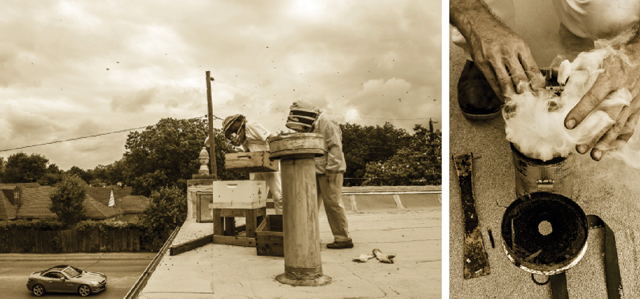
FEEDING THE SMOKER (Right) Brandon Pollard prepares a smoker, which he will use to calm the bees in a nearby pair of hives. Smoke sedates the insects, the beekeeper says, because they are hardwired to conserve energy for flight when anticipating a hive fire. Bee smoking is an ancient practice — 15,000-year-old cave paintings show people sedating bees with smoke. Photo by Danny Fulgencio
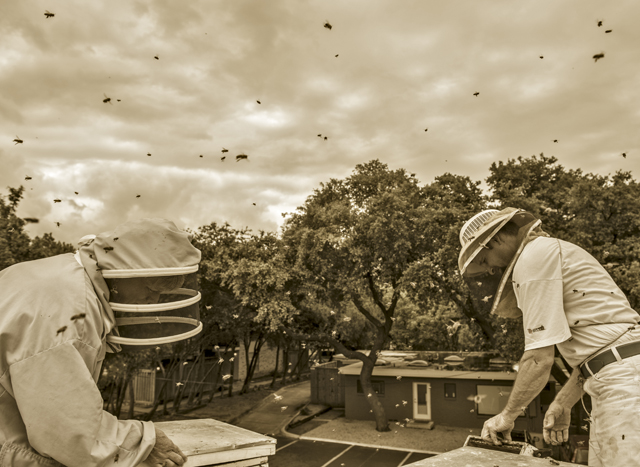
SUMMER SWARM Amid the buzz of new residents, Brandon and Susan Pollard finish installing hives on Corner Market’s rooftop. Photo by Danny Fulgencio
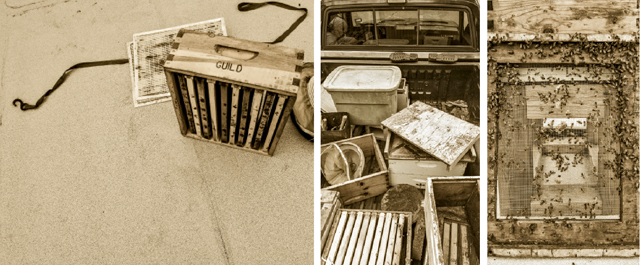
BEEKEEPER’S GEAR (Left and center) Aside from the heavy suits, beekeeping requires a load of gear and a pick-up with which to haul it all. The Pollards are pros and are ever equipped with beekeeping basics.
BEE SOCIAL (Right) Neighboring bees from different colonies collect on frames. When a new colony is brought to the location, the bees already in place cling to the box of newcomers. Brandon Pollard says bees from neighboring colonies sometimes support each other with food and water. Photo by Danny Fulgencio

MARCH AGAINST MONSANTO AT CITY HALL A thousand strong, protestors wind from City Hall toward the Farmers Market and back. Monsanto opponents blame the corporation, among others, for the drastic reduction of bee populations. The company has publicly denied that its products are the problem and has announced its intentions to help find a solution. Later that day, as the crowd thins, Brandon Pollard shakes his head, laments the lack of media presence and says, with a sad smile, “Preaching to the choir.” Photo by Danny Fulgencio


